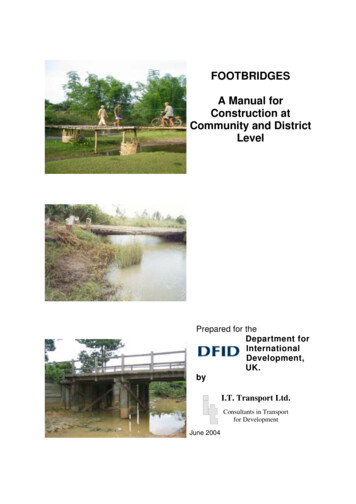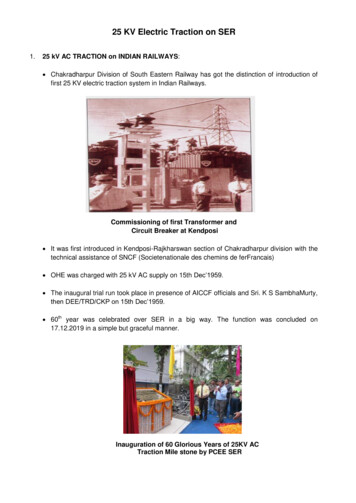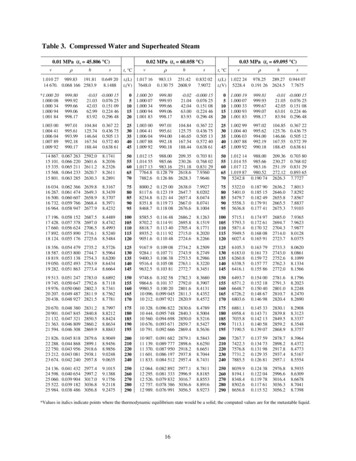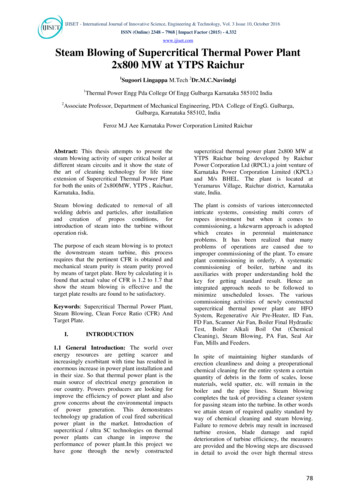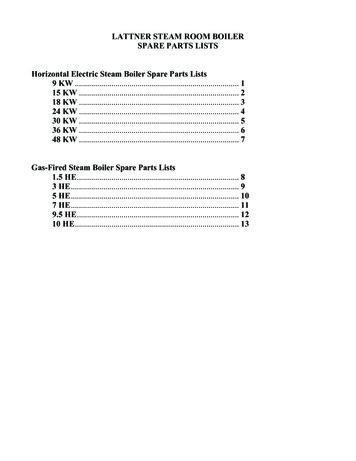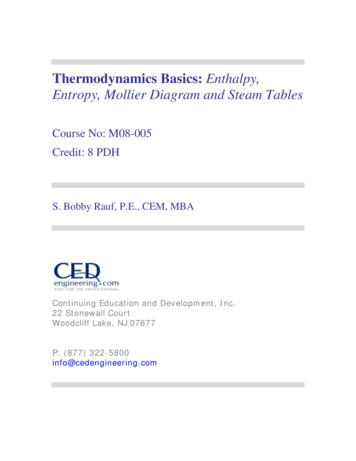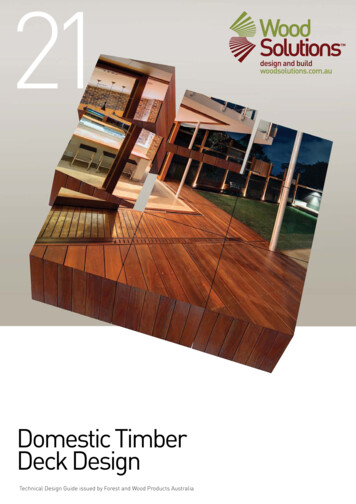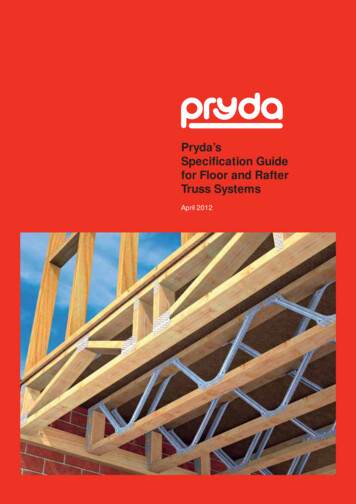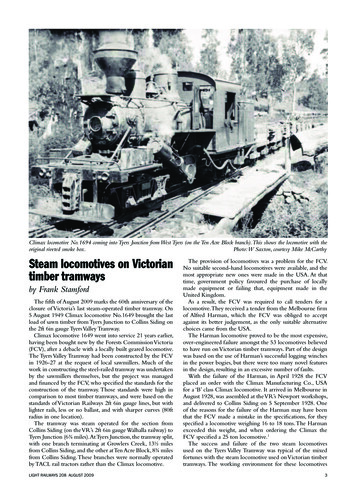
Transcription
Climax locomotive No.1694 coming into Tyers Junction from West Tyers (on the Ten Acre Block branch). This shows the locomotive with theoriginal riveted smoke box.Photo: W Saxton, courtesy Mike McCarthySteam locomotives on Victoriantimber tramwaysby Frank StamfordThe fifth of August 2009 marks the 60th anniversary of theclosure of Victoria’s last steam-operated timber tramway. On5 August 1949 Climax locomotive No.1649 brought the lastload of sawn timber from Tyers Junction to Collins Siding onthe 2ft 6in gauge Tyers Valley Tramway.Climax locomotive 1649 went into service 21 years earlier,having been bought new by the Forests Commission Victoria(FCV), after a debacle with a locally built geared locomotive.The Tyers Valley Tramway had been constructed by the FCVin 1926-27 at the request of local sawmillers. Much of thework in constructing the steel-railed tramway was undertakenby the sawmillers themselves, but the project was managedand financed by the FCV, who specified the standards for theconstruction of the tramway. Those standards were high incomparison to most timber tramways, and were based on thestandards of Victorian Railways 2ft 6in gauge lines, but withlighter rails, less or no ballast, and with sharper curves (80ftradius in one location).The tramway was steam operated for the section fromCollins Siding (on the VR’s 2ft 6in gauge Walhalla railway) toTyers Junction (6¾ miles). At Tyers Junction, the tramway split,with one branch terminating at Growlers Creek, 13½ milesfrom Collins Siding, and the other at Ten Acre Block, 8¾ milesfrom Collins Siding. These branches were normally operatedby TACL rail tractors rather than the Climax locomotive.LIGHT RAILWAYS 208 AUGUST 2009The provision of locomotives was a problem for the FCV.No suitable second-hand locomotives were available, and themost appropriate new ones were made in the USA. At thattime, government policy favoured the purchase of locallymade equipment or failing that, equipment made in theUnited Kingdom.As a result, the FCV was required to call tenders for alocomotive. They received a tender from the Melbourne firmof Alfred Harman, which the FCV was obliged to acceptagainst its better judgement, as the only suitable alternativechoices came from the USA.The Harman locomotive proved to be the most expensive,over-engineered failure amongst the 53 locomotives believedto have run on Victorian timber tramways. Part of the designwas based on the use of Harman’s successful logging winchesin the power bogies, but there were too many novel featuresin the design, resulting in an excessive number of faults.With the failure of the Harman, in April 1928 the FCVplaced an order with the Climax Manufacturing Co., USAfor a ‘B’ class Climax locomotive. It arrived in Melbourne inAugust 1928, was assembled at the VR’s Newport workshops,and delivered to Collins Siding on 5 September 1928. Oneof the reasons for the failure of the Harman may have beenthat the FCV made a mistake in the specifications, for theyspecified a locomotive weighing 16 to 18 tons. The Harmanexceeded this weight, and when ordering the Climax theFCV specified a 25 ton locomotive.1The success and failure of the two steam locomotivesused on the Tyers Valley Tramway was typical of the mixedfortunes with the steam locomotive used on Victorian timbertramways. The working environment for these locomotives3
The Harman geared locomotiveon a 5ft 3in gauge flat wagon readyfor transport to Moe. Photo:LRRSA Archives S Climaxlocomotive No.1694 at TyersJunction in the 1930s. Photo:Forests Commission VictoriaS No.1694 leavingTyers Junctionwith a load of sawn timber boundfor Collins Siding, in the late1940s.This shows the locomotivewith the new welded smokeboxwhich was made by the FCV.Photo: AP Wymond, courtesyMike McCarthy4LIGHT RAILWAYS 208 AUGUST 2009
was very demanding, the grades were steep, the curves sharp,the track usually rough and often appalling. Most owners ofsawmills and tramways had limited finances and maintenancefacilities, and limited availability of maintenance expertise.What the sawmill owners lacked in finances or formalknowledge was often compensated for with a willingness toinnovate or experiment with what they had available.As a result,the 53 locomotives varied from the sublime to the ridiculous.Thirteen were one-off designs, made either in the sawmiller’sown workshop, or by an engineering firm with no experiencein building steam locomotives. Five of these (including theHarman) did not get past the testing stage; what is moreamazing is that eight performed sufficiently well to put in atleast a few years service, and in some cases over 10 years service.The pioneersThe first tramway known to have used steam locomotiveswas that of Anderson Brothers, running from Dean, viaBarkstead, to Korweinguboora in the Wombat Forest, south ofDaylesford. The tramway was about 5ft 3in gauge, using ironstrapped wooden rails. Andersons had been using tramwaysfor 10 years when in 1873 they decided to try a locomotive.It was constructed by the mill’s fitter, Mr John Dalziel, using aGarrett traction or portable engine as a basis.Perhaps surprisingly – in view of the subsequent resultswith home made locomotives – it worked! So much so thatAndersons obtained a second locomotive, this time built bythe Union Foundry in Ballarat. Apparently a Marshall tractionor portable engine was used as a base, and the locomotive wasdescribed by a newspaper reporter as ‘having a double 8 inchcylinder with 14½ inch stroke on top of the boiler to allowits working by chain gear’. The locomotive had four coupledwheels, with a chain running from the front axle to a driveshaft on top of the boiler. It also worked satisfactorily.The twolocomotives remained in use on Andersons’ tramway – whichwas 23 km long – until 1886 when the Andersons left thesawmilling business. 2One of the reasons these locomotives were successfulwas probably that the Wombat Forest was less rugged andmountainous than most of the forest areas that were laterdeveloped.The next timber tramway locomotive was another tractionengine conversion, this time for the 3ft gauge Victoria SteamSawmill tramway at Warragul. This was built by the mill’sowner, Edwin Biggs, using flanged tramway wheels in placeof the original wheels. It is not clear how successful thislocomotive was.There are no subsequent newspaper referencesto its operation, and the Victorian Steam Sawmill closed in1890. In 1884 Biggs’ son, Frederick, is reported to be usingan engine to haul timber from his mill at Bloomfield, (nowNilma) station. It may have been the same unit, possiblyrunning as a traction engine again, as it was having a disruptiveeffect on the local horses.3The next known attempt to use steam locomotives wasat Garfield, on the main Gippsland railway, where in 1885William Brisbane, one of the principal shareholders in theCannibal Creek Sawmilling Company, tried a locomotive inOctober 1885. The only thing known of it is that, to quoteBrisbane it would ‘not answer when going around the curves’.It was reported that a second engine ‘made on a different principle’was under construction, but nothing further was recorded ofit. The rails of this tramway were wooden, of 4½ inch squaresection.4In 1886 the Longwarry Sawmilling Company hadconsiderably more success with a 3 ft gauge vertical-boileredlocomotive that they had built by the Melbourne engineeringfirm of Lugton & Sons. It was capable of hauling 30 tonsThe first locomotive on David Mitchell’s firewood tramway at Lilydale. It had geared drive to its four wheels, and was constructed around 1890, but bywhom is not known.Photo: Collection of A. (Sandy) Ross, Lilydale Historical SocietyLIGHT RAILWAYS 208 AUGUST 20095
Climax locomotive No.1694 draws water from Hotel Creek, about half-way between Tyers Junction and Collins Siding.Photo:W Saxton, courtesy Mike McCarthyat 8 mph on wooden rails, and in so doing met its designthe most active promoter of the project was drowned whilstspecifications. It hauled the daily output of sawn timber fromunloading some machinery, and the company never reachedthe Company’s Labertouche Creek and Gypsy Creek mills toits full potential. The locomotive was taken away before theLongwarry railway station, running two trips daily, but wassawmill went into operation. Nothing is known of its identitylimited to 4 mph due to the unstable wooden track. It is notbut it must have been small, as it had to be unloaded from aknown how long the locomotive was used, but the companyship in the open bay and lightered ashore.6became insolvent in 1893 and ceased operations.5Little is known of a four-wheel geared locomotive whichIn 1886 at Apollo Bay the Barham River Timber Companywas used by David Mitchell on a tramway on his Cave Hillwas being established, with a 3ft 6in gauge tramway. A smallestate at Lilydale, which supplied firewood to his lime works.locomotive was being used in the construction, and it wasPhotographs show that it was obviously home made (possiblyintended to use a locomotive on the completed tramway, butby a Melbourne engineering company) and indicate thatClimax locomotive 1694 at the Tyers Junction loco shed early one morning in 1947, with the cab filled with firewood ready for the day’s work.Photo: Norm Wadeson collection6LIGHT RAILWAYS 208 AUGUST 2009
the gauge was probably 3ft 6in. Mitchell was planning to usesteam in 1885, and the locomotive was probably in use in1890 and definitely in use in 1893, by which time the tramwaywas three miles long. Newspaper references also tell us thatMitchell was rebuilding and extending his tramway between1907 and 1910 along the valley of the Olinda Creek, beyondthe estate boundaries. It would have been at this time thegauge was changed to 4ft 8½ in, and an ex-Bendigo Phoenixtram motor obtained to work it. This worked successfully untilaround 1929 when the tramway was taken out of service.7To be continued.End Notes1. Wadeson, NE; ‘The Tyers Valley Tramway’, ARHS Bulletin, No.255, January1959. Stuckey, EG; ‘The Harman Geared Locomotive’, Light Railways No.42Summer 1972-73, pp.13-19. Stuckey, EG; ‘Climax Locomotive 1694’, LightRailways No.49 Spring 1974, pp.11-18.2. Houghton, Norm; Timber and Gold, LRRSA 1980; pp.21-23 & 283. McCarthy, Mike; Settlers and Sawmillers, LRRSA 1993, p.87 & 1074. McCarthy, Mike; Settlers and Sawmillers, LRRSA 1993, p.265. McCarthy, Mike; Settlers and Sawmillers, LRRSA 1993, p.396. Details provided by Norm Houghton7. Details provided by Phil Rickard, and are based on contemporary newspaperreports and records in the Victorian Public Records Office. Alger, Ralph;‘Reminiscences of the Cave Hill Tramway’, Light Railways No.111, pp.3-149LFWRULD¶V VWHDP RSHUDWHG WLPEHU DQG ¿UHZRRG WUDPZD\V7UDPZD\GaugePeriod of steam operation1870Andersons’ — Dean — KorweingubooraVictoria Steam Sawmill — WarragulCannibal Creek Sawmilling Co. — GarfieldLongwarry Sawmill Co. — LongwarryBarham River Timber Co. — Apollo BayDavid Mitchell — LilydaleCropley Bros — Darnum — EllinbankMason & Co. — Port WelshpoolAustralian Seasoned Timber Co. — WandongSanderson & Grant — ForrestW.W. Gunn — CrossoverJohn F. Anderson — WarburtonNorth Long Tunnel Gold Mining Co. —WalhallaMcIvor Timber & Firewood Co. — TooboracPenrose & Oddy — MitchellstownCuming, Smith & Co. — Britannia CreekHayden Bros — Barwon DownsWarburton Steam Tramway — WarburtonGoodwood T. & T. Co. — Port AlbertHenry & Sons — ForrestRubicon Lumber & Tramway Co. — AlexandraVictorian Powell Wood Process — PowelltownHigg’s Mill — Whittlsea — Pheasant CreekLoch Valley Timber Co. — NoojeeGoodwood Timber & Tramway Co. — NoojeeElphinstone Redgum Sawmilling Co.EAC Russell — GembrookJE Ezard — Big Pats CreekRichard’s — Big Pats CreekForests Commission — Tyers ValleyJE Ezard — Erica1880 18901900 19101920 1930 19401950c.5ft 3in3ft3ft3ft3ft 6inc.3ft 6in4ft 8½in3ft3ft3ft 6in3ft 6in3ft 6in3ft2ft 6in5ft 3in3ft3ft3ft 6in3ft2ft3ft 6in2ft3ft3ft3ft 6in3ft 6in3ft 6in3ft3ft3ft2ft 6in3ftLine thickness equals estimated number of locomotives (from 1 to 6)LIGHT RAILWAYS 208 AUGUST 20097
load of sawn timber from Tyers Junction to Collins Siding on the 2ft 6in gauge Tyers Valley Tramway. Climax locomotive 1649 went into service 21 years earlier, having been bought new by the Forests Commission Victoria . Barham River Timber Co. — Apollo Bay 3ft 6in David Mitchell — Lilydale c.3ft 6in 4ft 8½in Cropley Bros — Darnum .

